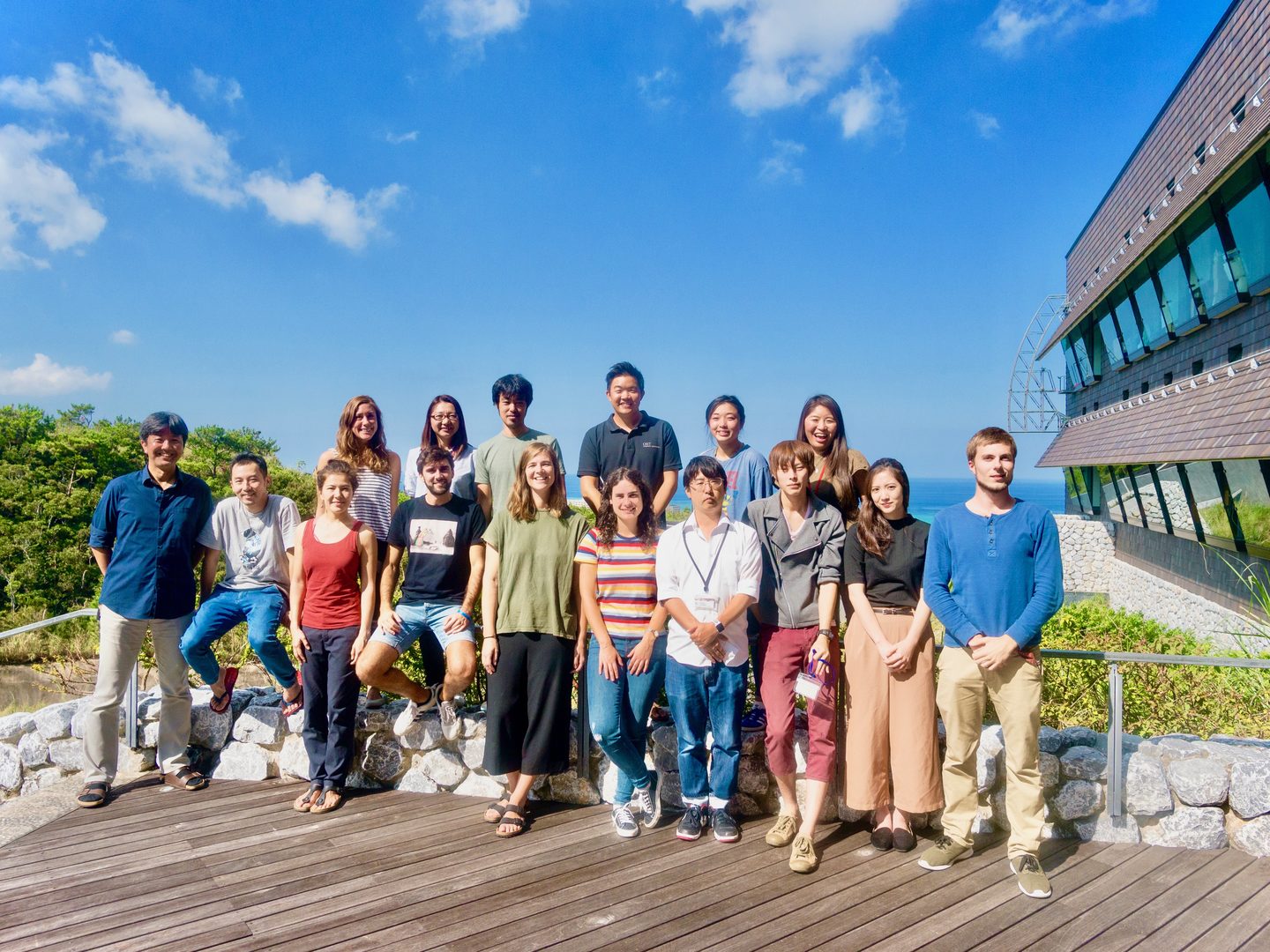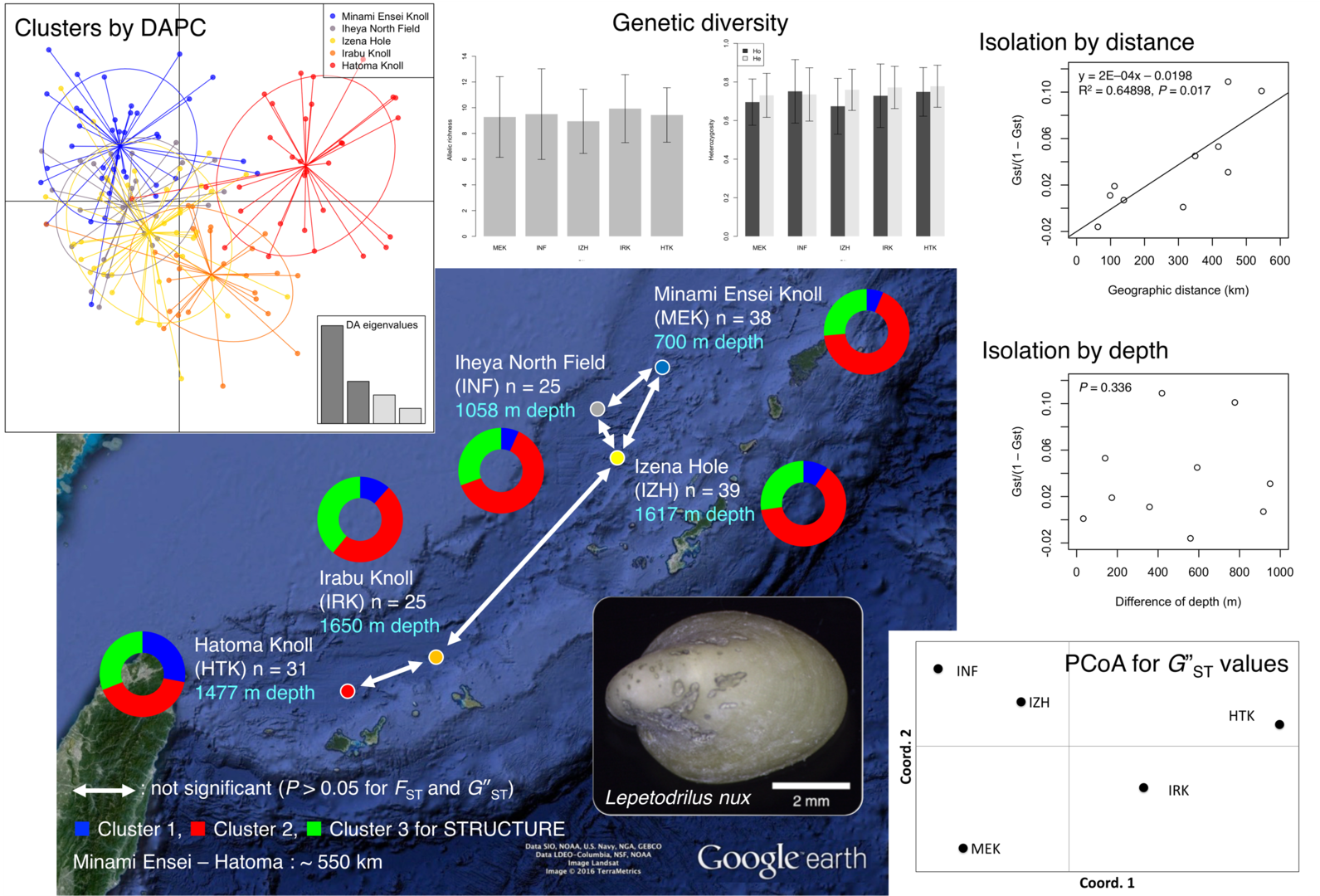FY2017 Annual Report
Marine Biophysics Unit
Associate Professor Satoshi Mitarai

Abstract
Marine Biophysics Unit will develop forecasting system for the coastal ocean circulation processes around Okinawa and implement a validated connectivity assessment tool, coupling available modeling and observation techniques. This modeling tool will
Help marine biologists and genetics estimate rates of geneticists estimate rates of gene flow among sites,
Enable public agencies to build and evaluate marine protected areas based on population connectivity, and
provide marine ecologists with a modeling system for predicting the global and long-term dynamics of the marine ecosystem
Marine Biophysics Unit was established on Sep. 1, 2009 when Satoshi Mitarai joined OIST.
1. Staff
- Satoshi Mitarai, (September 2009 –)
- Yuichi Nakajima, Postdoctoral Scholar (August 2013 –)
- Angela Ares Pita, Postdoctoral Scholar (August 2017 –)
- Marine Le Gal, Postdoctoral Scholar (September 2017 –)
- Kirk Sato, Postdoctoral Scholar (September 2017 –)
- Yuta Nunome, Technician (May 2014 – January 2018)
- Kazumi Inoha, Technician (April 2015 –)
- Otis Brunner, Technician (April 2017 – August 2017)
- Yuko Hasegawa, Technician (April 2017 –December 2017)
- Hiroshi Izumi, Technical Staff (February 2018 –)
- Patricia Wepfer, Graduate Student (January 2014 –)
- Maki Thomas, Graduate Student (September 2015–)
- Margaret Mars Brisbin, Graduate Student (September 2015 –)
- Christina Ripken, Graduate Student (September 2015 –)
- Po-Shun Chuang, Graduate Student (September 2015 –)
- Akiko Guzman, Research Administrator (April 2017 –)
2. Collaborations
2.1 Larval dispersal of coral reef species
- Type of collaboration: Joint research
- Researchers:
- Prof. K. Sakai, University of the Ryukyus
- Prof. M. Nakamura, Tokai University
2.2 Larval dispersal of hydrothermal vent species
- Type of collaboration: Joint research
- Researchers:
- Dr. H. Yamamoto, Japan Agency for Marine-Earth Science and Technology
- Dr. Y. Furushima, Japan Agency for Marine-Earth Science and Technology
- Dr. D. Lindsay, Japan Agency for Marine-Earth Science and Technology
- Dr. H. Watanabe, Japan Agency for Marine-Earth Science and Technology
- Dr. M. Sunamura, Japan Agency for Marine-Earth Science and Technology
- Dr. C. Chen, Japan Agency for Marine-Earth Science and Technology
2.3 Regional ocean circulation modeling
- Type of collaboration: Joint research
- Researchers:
- Prof. J. McWilliams, University of California, Los Angels
- Dr. A. Shchepetkin, University of California, Los Angels
- Prof. Y. Uchiyama, Kobe University
2.4 Okinawa coastal ocean observing system
- Type of collaboration: Joint research
- Researchers:
- Okinawa Prefectural Fisheries and Ocean Research Center
- 11th Japan Regional Coast Guard
2.5 Mesophotic coal ecosystem diversity and spatial distribution along the western cost of Okinawa
- Type of collaboration: Joint research
- Researchers:
- Prof. J. Reimer, University of the Ryukyus
3. Activities and Findings
3.1 Larval dispersal contributes to genetic diversity and connectivity of
limpet (Lepetodrilus nux) populations in the Okinawa Trough
Various invertebrate species maintain chemosynthetic ecosystems around deep-sea hydrothermal vents. For vent-endemic benthos, larval recruitment is presumably critical for population maintenance and colonization via dispersal among hydrothermal vent sites. The lepetodrilid limpet, Lepetodrilus nux, is a hydrothermal vent-endemic species and one of the most abundant gastropods at hydrothermal vents in the Okinawa Trough, in the northwestern Pacific Ocean. However, detailed assessment of genetic diversity and connectivity based on individual genetic profiles has not been possible previously. We examined these parameters in L. nux at five hydrothermal vent sites (maximum geographic distance: ~550 km, depth range: ~700 m to ~1,650 m) using population genetic analysis of 14 polymorphic microsatellite loci. Genetic diversity based on allelic richness and expected heterozygosity has been maintained at hydrothermal vent sites investigated. Meanwhile, low genetic differentiation among populations was detected and pairwise FST values ranged from –0.003 to 0.023 and G”ST values ranged from –0.016 to 0.098. Genetic clustering relatively reflected the geographic distance among sites. There was a relationship between genetic differentiation and geographic distance (P = 0.010 in FST, P = 0.017 in G”ST), but there was no relationship with depth (P = 0.350 in FST, P = 0.336 in G”ST). Relative migration rates also showed a tendency toward isolation-by-distance, but migration direction was not necessary unidirectional. Larvae of L. nux apparently ascend via the thermal plume to wander in the water column, utilizing currents closer to the surface for stochastic long-distance dispersal. This behavior suggests that stochastic stepping-stone dispersal contributes significantly to population connectivity and maintenance of this species in the Okinawa Trough.

Figure 1: Genetic diversity has been maintained each vent site and genetic differentiation is low between most populations (FST = –0.003–0.023, G”ST = –0.016–0.098), but significant between distant vents in Lepetodrilus nux. Genetic structure was confirmed among vent sites, and different clusters were identified by DAPC. Each population is maintained by “stepping-stone” connectivity within the Okinawa Trough, regardless of the depth. Details about microsatellite markers are provided in Nakajima et al. (2017).
4. Publications
4.1 Journals
-
Nakajima, Y., Shinzato, C., Khalturina, M., Nakamura, M., Watanabe, H. K., Nakagawa, S., Satoh, N., Mitarai, S. Isolation and characterization of novel polymorphic microsatellite loci for the deep-sea hydrothermal vent limpet, Lepetodrilus nux, and the vent-associated squat lobster, Shinkaia crosnieri. Marine Biodiversity, doi: doi.org/10.1007/s12526-017-0704-5 (2017).
-
Kamidaira, Y., Uchiyama, Y., Mitarai, S. Eddy-induced transport of the Kuroshio warm water around the Ryukyu Islands in the East China Sea. Continental Shelf Research, doi: doi.org/10.1016/j.csr.2016.07.004 (2017).
-
Nakajima, Y., Wepfer, P. H., Suzuki, S., Zayasu, Y., Shinzato, C., Satoh, N., Mitarai, S. Microsatellite markers for multiple Pocillopora genetic lineages offer new insights about coral populations. Scientific Reports, doi: doi.org/10.1038/s41598-017-06776-x (2017).
-
Sato, K. N., Powell, J., Rudie, D., Levin, L. A. Evaluating the promise and pitfalls of a potential climate change–tolerant sea urchin fishery in southern California. ICES Journal of Marine Science, doi: doi.org/10.1093/icesjms/fsx225 (2017).
-
Mullineaux, L. S., Metaxas, A., Beaulieu, S. E., Bright, M., Gollner, S., Grupe, B. M., Herrera, S., Kellner, J. B., Levin, L. A., Mitarai, S., Neubert, M. G., Thurnherr, A. M., Tunnicliffe, V., Watanabe, H. K., Won, Y. Exploring the Ecology of Deep-Sea Hydrothermal Vents in a Metacommunity Framework, Frontiers in Marine Science. doi: doi.org/10.3389/fmars.2018.00049 (2018).
4.2 Books and other one-time publications
Nothing to report
4.3 Oral and Poster Presentations
([NOTE] *Seminars and workshops by OIST faculty/unit members (either with or without other speakers), either at OIST or at other institutions than OIST, should be included in the 4.3 Oral and Poster Presentations.
-
Mitarai, S. Quantifying Dispersal from Hydrothermal Vent Fields in the Western Pacific Ocean, 6th International Symposium on Chemosynthesis-Based Ecosystems (CBE6), Woods Hole, Mass, USA, 2017.09.01 (2017).
-
Nakajima, Y., Nakamura, M., Watanabe, H., Mitarai, S. Stepping-stone larval dispersal contributes to genetic diversity and connectivity among populations of a hydrothermal vent limpet in the Okinawa Trough, 6th International Symposium on Chemosynthesis-Based Ecosystems (CBE6), Woods Hole, Mass, USA, 2017.08.27-09.01 (2017).
-
Shirayama, Y., Mitarai, S., Kawauchi, M., Xiaobo, L., Kankee, T., Yamamoto, H. Marine environmental assessment and management, Annual meeting of the Research and Development Center for Submarine Resources, Tokyo, Japan, 2017.09.08 (2017).
-
Le Gal. M., Violeau, D., Ata, R. Simulation of the Tohoku-Oki tsunami with Telemac, the French-Japanese Week on Disaster Risk Reduction, Tokyo, Japan, 2017.10.04 (2017).
-
Brisbin, M. M., Grossmann, M. M., Mitarai, S. Friend or Foe: A Multiple Meta Omics Investigation into the Nature of the Acantharea-Phaeocystis Symbiosis, 2018 Ocean Sciences Meeting, Portland, Oregon, USA, 2018.02.15 (2018).
-
Thomas, M. K., Nakajima, Y., Mitarai, S. Intra- and Inter-Island Propagule Transport of Mangrove Species in Northern West Pacific, 2018 Ocean Sciences Meeting, Portland, Oregon, USA, 2018.02.13 (2018).
-
Mitarai, S., McWilliams, J. C., Grossmann, M. M., Gallager, S. Wave Glider Observations of Surface Winds and Currents in the Core of Typhoon Danas, 2018 Ocean Sciences Meeting, Portland, Oregon, USA, 2018.02.14 (2018).
-
Wepfer P.H., Nakajima Y., Economo E.P., Mikheyev A., Mitarai S. Dispersal Patterns of the Coral Galaxea fascicularis across the Northwestern Pacific Ocean, 2018 Ocean Sciences Meeting, Portland, Oregon, USA, 2018.02.11-02.16 (2018).
-
Sato, K. N., LA Levin. Climate Change and ENSO Impacts on Southern California Sea Urchins: Informing Fisheries Management Adaptation Plans, 2018 Ocean Sciences Meeting, Portland, Oregon, USA, 2018.02.15 (2018).
5. Intellectual Property Rights and Other Specific Achievements
Nothing to report
6. Meetings and Events
Nothing to report.
7. Other
Nothing to report.



